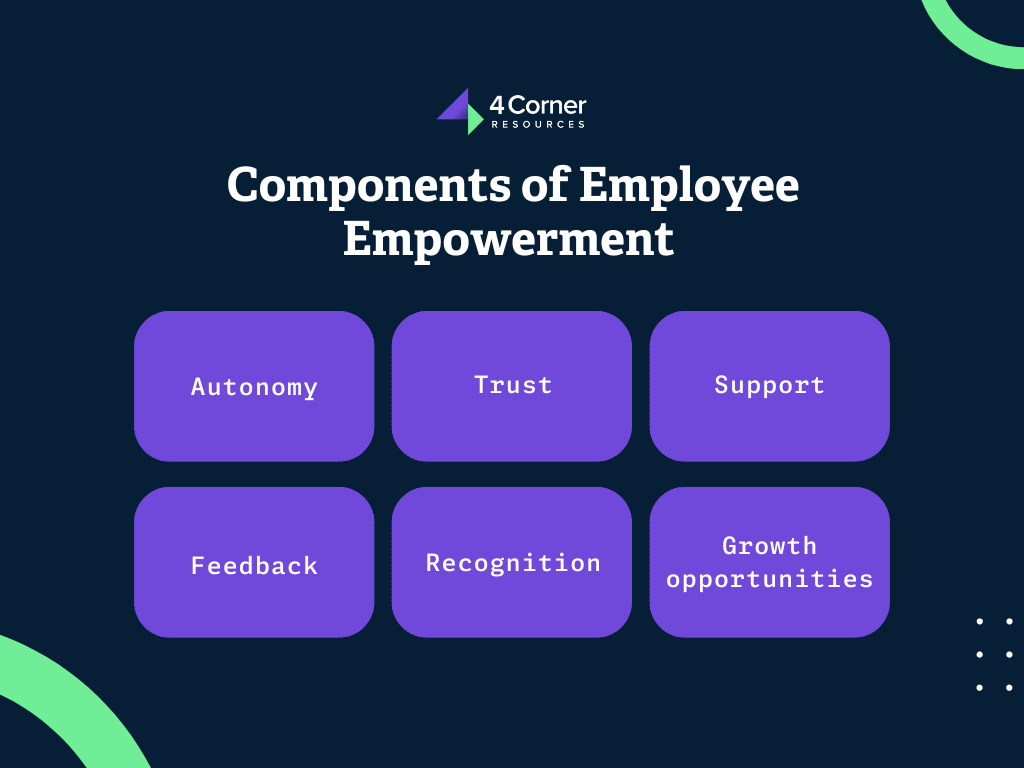Empowerment in the Workplace: What It Is and Why It Matters

There’s no question that empowering employees brings numerous positive effects for both a company and its workers. Empowerment in the workplace has proven time and time again to be associated with better job performance, higher employee satisfaction, and a stronger sense of commitment to the company.
A study from Zenger Folkman of more than 7,000 employees demonstrated that empowerment and engagement are closely linked. The research found that employees who felt a low level of empowerment scored around the 24th percentile in engagement, while those who felt highly empowered showed engagement scores around the 79th percentile.
But what exactly does employee empowerment mean, and how can organizations ingrain it into their culture? We’ll define empowerment in the workplace, explore why it’s so important, and reveal some actionable strategies for making it a reality in your place of work.
What Is Empowerment in the Workplace?
Empowerment in the workplace means enabling employees to take ownership of their work and contribute to meaningful decision-making. In a culture of empowerment, company leaders delegate responsibilities, share information freely, and seek out input from members of their team.
A culture of empowerment isn’t just about how company leaders treat employees; it’s also about what is asked of them in return. When you empower your employees, you hold them to a higher standard, set ambitious goals, and establish an expectation that they’ll take accountability for their performance.
Employee empowerment can help organizations motivate workers, retain top talent, and achieve optimal business outcomes when executed correctly.
Why Is Employee Empowerment Important?
Empowerment in the workplace is a net positive for workers, managers, and organizations as a whole. Here are a few of the top benefits of empowering your employees.
Improve engagement
Empowering employees yields the most dramatic impact on employee engagement. Empowered employees feel more invested in their company’s mission, are more willing to step up when extra work is required, and are more likely to make contributions that can lead to meaningful change. When employees can take ownership of their work, they’re more invested in doing a good job and feel a stronger sense of pride when they accomplish a goal.
Find the perfect fit for your team.
Speak to one of our recruiting experts today.
Retain top talent
One aspect of employee empowerment is catering to workers’ strengths–capitalizing on what they’re good at and interested in. When employees are doing a good job, they’re more likely to enjoy it, and workers who are happy at their jobs are more likely to stick around.
Another aspect of empowerment in the workplace is recognizing employees for a job well done. This contributes to stronger retention since top performers want to work at a company where they feel that their contributions are valued.
Related: Effective Strategies for Employee Retention
Accelerate professional development
Managers who empower their reports constantly support professional development, provide regular feedback, and seek out opportunities to increase their employees’ knowledge. Professional development is beneficial personally since it feeds into employee engagement. Still, it’s also a win for the organization, which reaps the benefits of a more skilled workforce.
Related: Ways to Invest in Employee Development
Support strong leaders
At the organizational level, empowerment in the workplace means trusting that managers know their teams best. When empowered, managers can better connect with their staffers and provide what their team needs to succeed. Empowered managers are transparent with information that employees value and processes become more optimized thanks to direct input from the employees who work through those processes daily.
Strengthen financial performance
Adaptability is one of the strongest predictors of an organization’s financial success. Empowered workers are more likely to embrace and even be drivers of change, which can yield creative solutions and innovative business developments. Research has found that employees with autonomy are more likely to feel responsible for their jobs and engage in change-oriented behavior like proactive problem-solving. When you empower employees, they’re motivated to do good work, which is always an upside from a business perspective.
What are the Components of Employee Empowerment?

To promote empowered employees, organizations should embrace the following principles.
Autonomy
This is a big one, especially in the current landscape where employees desire flexibility more than any other quality from their employer. It’s also one of the toughest to accomplish because it requires letting go of control. Embracing autonomy means allowing workers to make decisions on things like how their time is spent and when and where they do their best work. It requires leaders to delegate generously and allow employees to take full ownership of tasks with minimal oversight.
Trust
Trust goes hand in hand with autonomy. You have to give trust in order to receive it. For example, a manager handing over a task without micromanaging how it will get done demonstrates their confidence in the employee’s ability to deliver a completed product successfully. Trust also means sharing information freely and maintaining open lines of communication across departments and seniority levels.
Support
Empowered employees feel like their managers have their back. Managers should feel comfortable and willing to go to bat to help their employees do their best work, including lobbying for resources, tools, technology, funding, and leadership buy-in.
Feedback
Giving clear, constructive criticism and positive feedback ensures employees understand what is expected of them. This allows them to take ownership of their work without ambiguity.
Related: The Best Employee Survey Tools for Gathering Actionable Feedback
Recognition
Organizations that succeed at empowerment recognize employee achievements–but not only achievements. After all, there are only so many goals a team member can hit in a quarter or a year. Empowering companies also dole out praise for progress toward goals, performance improvements, and positive contributions like being a strong team player.
Growth opportunities
Companies must prioritize employee development to empower employees. Promoting opportunities like leadership training and internal mobility not only boosts engagement but also helps ensure the organization possesses the skills required to achieve long-term business goals.
How to Implement a Culture of Empowerment in the Workplace
1. Start at the top
You can’t have empowered employees without an empowered leadership team. When an employee brings a concern to their manager, the answer should never be, “It’s out of my control,” but rather, “I’ll see what I can do about it.”
To achieve true empowerment in the workplace, an organization must fully support its managers and provide for their needs. This means investing in leadership training, giving managers autonomy in their decision-making, and engaging them in conversations about the company’s future.
2. Embrace transparency
Empowering employees revolves heavily around allowing them to take ownership of their work, but it also requires a heavy dose of communication. An organization with a culture of empowerment gives employees the information they need to have a thorough understanding of the business and its goals, which helps them make stronger decisions and be more successful at their jobs. Leadership should communicate the company’s mission, objectives, and direction clearly and often.
3. Listen to employees
There’s a reason customer surveys are so effective when optimizing a product–because they gather feedback from the people who directly use and experience that product. It’s no different when you’re looking to optimize your business. You have to gather input from the people who work in that business. Employees can be the most amazing source of transformative change–if you listen to their contributions.
Give them channels to express their feedback, then ask for it regularly. Use tools like employee advisory panels to include the worker’s voice in company decision-making.
Related: How to Measure Employee Satisfaction
4. Make space for creative work
It’s hard for employees to feel engaged with their work if they’re boxed into a rigid set of tasks every hour they’re on the clock. Give staffers space to stretch beyond their typical skill sets by involving them in new and interesting projects. Offer direction and provide structure, then back off and see what they come up with. This not only builds trust between managers and teams but gives employees a chance to develop new skills.
5. Hold employees accountable
Empowerment in the workplace isn’t all sunshine and daisies. Giving workers autonomy means sometimes they’re going to make the wrong decisions. There will be failures and disappointments. In a culture of empowerment, managers support their employees in taking ownership of those failures, analyzing how they happened, identifying lessons learned, and forging a path forward with newfound insights.
6. Prioritize company culture
We’ve mentioned company culture several times already, but it’s not something where you just say the word ‘empowerment,’ and it materializes overnight. Building a culture of empowerment requires strategic planning and intentional decision-making over the long term. It also requires putting your money where your mouth is and allocating resources to initiatives that support employee well-being, innovation, creative thinking, and transparency.
7. Invest in technology
It’s impossible for employees to feel empowered if the tools they have to do their jobs aren’t functional. Any rhetoric about empowerment will immediately be undermined by outdated software, broken equipment, and ineffective systems.
Invest in the tools and technology that enable workers to get the needed information, communicate with colleagues, work faster, and optimize tasks. This is a great opportunity to walk the walk by listening to your employees and asking what they need.
8. Focus on the why
Leadership experts from Harvard Business School advise that rallying employees around a shared purpose is one of the best ways to mobilize a team. To do this, clearly delineate the organization’s mission and its driving force, like improving customers’ health, making people’s lives easier, using technology to drive change, etc. Use this ‘why’ as a compass when making decisions; it’s not the right move if an initiative doesn’t contribute to the purpose.
9. Promote inclusiveness
Building a culture where diversity and inclusion are valued ensures that all employees feel empowered regardless of their background. Highlighting different perspectives and talents leads to more creative, resilient teams where employees feel comfortable letting their unique attributes shine.
10. Incentivize key performance goals
Use incentive programs to reward employees for hitting performance milestones and exceeding growth goals. Rewarding employees for their contributions motivates further achievements while helping to align employees’ individual goals with organizational objectives.
Empowerment in the Workplace Examples
Here are some tangible examples of what employee empowerment looks like:
- Conducting employee feedback surveys to ask what needs improvement
- Assembling an employee task force to come up with creative ways to address a problem
- Using a gamification tool to recognize employees for their contributions
- Hosting a training retreat for managers
- Providing a stipend for continuing education
- Letting employees set their own work schedule
- Giving floating holidays for volunteer work
- Establishing a mentorship program
As you can see, empowerment in the workplace can take many different forms. At its core, it’s about trusting workers to do the jobs they were hired to do and continuously supporting them with the resources they need to improve, ultimately yielding better business outcomes.
